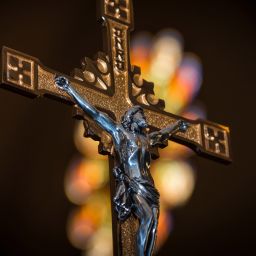By Father Thomas Esposito, O. Cist
Special to The Texas Catholic
I recently accompanied a group of University of Dallas students and young alumni to the Holy Land, and I would like to share some musings about Christian faith and pilgrim feet based on that blessed experience.
One obvious privilege of such a pilgrimage is the opportunity to stand on the very stones where God incarnate, His mother, and His disciples stood, and to pray where He and they prayed. Remnants of faithful Christian devotion are beautifully displayed at Capernaum, probably my favorite site in the Holy Land. We celebrated Mass at this village on the northwest shore of the Sea of Galilee; our altar was on the shore itself, just a few feet from the house of Simon Peter. Jesus apparently used this square building as the headquarters of his public ministry; Capernaum was known as his “home” (Matthew 9:1; Mark 2:1). It was in this house that Jesus cured Peter’s mother-in-law “as soon as they left the synagogue” about thirty feet away (Mark 1:29), the Jewish house of worship identified as the setting for Jesus’ Bread of Life discourse (John 6:59). The thatch roof of this single-story home (or one nearby) was removed by four friends who lowered their paralytic friend to be healed by the Lord (Mark 2:1-12).
Another privilege for me was a heightened awareness of the pilgrim nature of the Church, and the beauty of uniting my steps with those of countless Christians who have made the same journey in previous centuries. My colleague in the history department, Dr. Jon Paul Heyne, had our students read accounts of pilgrimage adventures written by his “dead friends”: a woman named Egeria from the 4th century and the 14th century Franciscan Fra Niccolò of Poggibonsi. We became much more patient with the modern annoyances of travel after reading that Fra
Niccolò was arrested and nearly beaten to death when he first set foot in the Holy Land!
One stirring example of this pilgrim camaraderie with the living and the dead is found in the basilica of the Holy Sepulchre. Just inside the main entrance, a winding and narrow flight of stairs leads to Calvary. The marble steps have been visibly smoothed and curved by the foot traffic of centuries, touched by believers who, like us, celebrated Mass at the site of Jesus’ death and touched the Golgotha stone that held the wood of His cross, our triumph over death.
But what specifically is the privilege of being, standing, and praying at these sites? The altar stone at Nazareth’s basilica of the Annunciation reads, “The Word became flesh here.” A similar sign in the church of the Nativity in Bethlehem reminds us that Jesus was born here, and the liturgies proper to each place make constant reference to the in-this-place-ness of the Gospel stories. While every Eucharist brings Jesus fully present to us in our here and now, only these sites can boast of hosting the initial gift of God in the flesh, of receiving His very footsteps. The grace channeled through these holy places ensures that my students and I possess treasured visuals of the events narrated in the Gospels whenever we read or listen to them.
As pilgrims, we were aware that we could not linger indefinitely in the Bethlehem cave; we were ordered to keep our Mass at Calvary short, and each of us had about five seconds of quiet in the Holy Sepulchre itself before we were ordered to make way for other pilgrims! Our brief stay in the land of Jesus’ earthly past must point us to the future: God has granted us these blessed experiences so that they might act as lights, as beacons of consolation, sustaining us and others in later times of distance and darkness. To walk the Via Dolorosa —literally in Jerusalem, but also now in memory and liturgy — is to be near Christ wherever our here, whenever our now, may be. We pilgrims also realize (joyfully, I hope) that what we found in Jesus’ dwellings at Nazareth and Capernaum must be mirrored in our own hearts, so that Christ might dwell in us as He did long ago in these sacred sites, so that He might bless others through us. One student, Elise DeGeeter, expressed this insight beautifully when she reflected on what she will take home from her time in Jesus’ adopted hometown: “In visiting Capernaum — Jesus’ home — I was able to interact more deeply with his personhood and wonder at his marvelous ways. I could sense the omnipresence of God in a much more powerful and real way, walking through the ancient ruins. And I pray, with each step in Capernaum, that I, too, can be a home for Christ.”
Father Thomas Esposito, O. Cist., is a monk at the Cistercian Abbey of Our Lady of Dallas and teaches in the theology department at the University of Dallas.
















